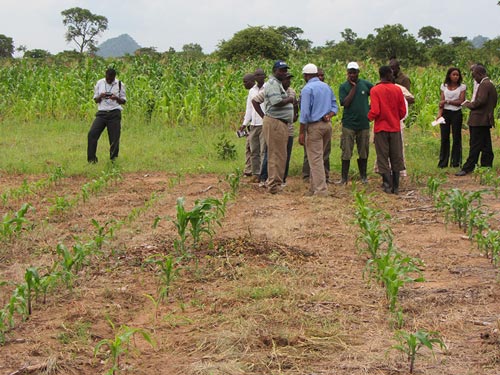By Jens A. Andersson and Peter Setimela/CIMMYT
CIMMYT researchers in eastern Zambia have discovered that farmers continue to grow land races alongside new, higher-yielding varieties as a risk-avoidance strategy. The Sustainable Intensification of Maize-Legume Systems for the Eastern Province of Zambia (SIMLEZA)- Africa Rising project, funded by the USAID Feed the Future Initiative, hosted a field tour for researchers and journalists at the end of January.
They visited on-station experiments at the Msekera research station and trials on farmer fields, including conservation agriculture, cowpea, maize and soy variety trials. The Katete District, bordering Mozambique, looks very different from last year’s field tour. In 2013, the trial plots featured green maize ready to tassel; this year, the plots have maize plants measuring 30cm. Maize in the trial plots was planted only a month ago due to the rainy season’s late start. Outside of the trial plots is maize as it commonly looks in Eastern Zambia; it varies in color, from dark green to yellow, and has an uneven crop stand.

Different planting dates and the levels and timing of fertilizer application are the major reasons for this variability. Among this variation one also observes very tall and already tasseling maize. These are low-yielding landraces that were dry-planted in October. Farmers will be able to harvest them in the next few weeks. Why would Zambian smallholder farmers plant low-yielding landraces when high-yielding, open-pollinated varieties (OPV) and hybrid varieties are available? The answer is usually sought at the household level; smallholder farmers are taken to prefer landraces for their taste and storability.
Yet, those reasons are only part of the answer. In Zambia, most farmers do grow and eat OPVs and hybrids. Certified seed is widely available from agrodealers and is distributed through the government’s Farm Input Subsidy Programme (FISP), which provides smallholders with a package of 100 kilograms (kg) of basal fertilizer, 100 kg of top dressing fertilizer and 10 kg of hybrid maize seed for a nominal price. In addition, the Zambian government has instituted a good market for maize. Its Food Reserve Agency (FRA) offers high prices and buys locally and has turned maize into a lucrative cash crop.
Zambian farmers have responded to these institutional changes; they dedicate larger plots to the cultivation of hybrid maize. The SIMLEZA-Africa Rising project builds on these changes; in addition to improving agronomic practices for maize and legume cultivation in Eastern Zambia, it introduces and demonstrates new maize varieties, including drought-tolerant maize hybrids. The project expands farmers’ options for increased maize production. Three new varieties were recently released while collaboration from seed companies ensures that farmers can access them for fair prices.
A recent survey by the project found that once farmers are aware of SIMLEZA maize varieties, nearly half cultivate them. Why do farmers in this part of rural Zambia continue to grow landraces next to high-yielding ones, instead of switching to high-yielding varieties altogether? For farmers in Kawalala village, it is about agronomic and institutional risks. Dry-planting is a gamble, as limited first rains may result in crop failure and necessitate replanting. Zambian farmers are therefore reluctant to use expensive seeds and fertilizer when dry-planting; they often only apply basal fertilizer after the maize has germinated. “We only plant certified seed with good rains; otherwise, you lose money,” explained farmer Gertrude Banda.
But the highly uneven maize crop stand in Kawalala is not merely a difference between early-planted, tallgrowing landraces and late-planted hybrids. Farmers also delayed planting hybrids on account of late payments by the FRA for last season’s crop; they lacked the cash to buy seeds and fertilizers in time. Others had to wait for the FISP input packages that were distributed late – even now, as their maize turns yellow, some farmers are still waiting for their FISP top dressing fertilizer.
With institutional risks such as late payment and input delivery, it is clear that there remains a niche for local maize varieties. But this niche may soon be filled by OPVs that cost less and produce greater yield, such as the MV409 variety, introduced by SIMLEZA-Africa Rising. OPVs do not require farmers to purchase new seed annually. New hybrid varieties may take time to be adopted by the majority of farmers, but farmers in Kawalala involved in the project are convinced that they will increasingly be grown.
 Capacity development
Capacity development